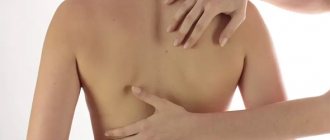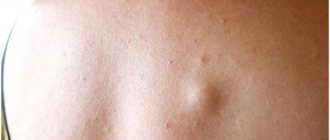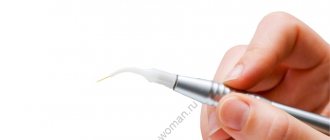“Lump under the skin” and “wen” - this is not exactly how we call atheroma. However, it is almost impossible to independently determine atheroma. Therefore, in order to eliminate the risk of more serious neoplasms, it is recommended to visit a surgeon with any unexpectedly “grown” lump under the skin.
No need to worry. Atheroma - benign formation
, which in itself does not pose a serious threat to the body.
But despite all its harmlessness, atheroma requires mandatory removal
. Paradox? Not at all!
Let's take a closer look at why.
Is it necessary to remove atheroma if it is harmless?
- All atheromas are continuously growing
. And in some cases - extremely quickly. If the atheroma is not removed on time (that is, as early as possible), it becomes larger and larger, sometimes reaching gigantic proportions! Medicine knows of atheromas the size of a child’s head.
- As the atheroma grows, it becomes visible to the naked eye. And if atheroma on the body can be hidden for a long time under clothing, ugly bumps on the face and head arouse the morbid curiosity of others.
- The contents of atheroma often leak out, ruin clothes and have an extremely unpleasant odor that cannot be masked.
- Atheroma is a chronic inflammatory lesion that has negative health consequences. Do you often get colds, get tired, want to sleep, and find it difficult to stand 8 hours at work? All these symptoms are her work.
- The larger the atheroma reaches, the wider the incision is required to remove it. The more difficult it is to hide the scar and skin sagging.
- The contents of atheroma are sebum. This is a delicious delicacy for bacteria. Accumulating sebum, atheroma grows and gradually turns into a time bomb. Infection in the atheroma guarantees the development of purulent inflammation
.
Removing pus from the atheroma will require a large incision, which will leave behind a scar. But greater operational access to atheroma is not the only consequence of suppuration. Such an area rarely heals beautifully, and a painful keloid scar often forms in place of the inflamed atheroma.
The Platinental Clinic offers all the most modern methods for removing atheromas:
- without pain,
- without seams,
- replenishment of tissue volume after removal of atheroma,
- numerous techniques for forming invisible scars.
You can make an appointment with a surgeon online or by phone.
Complications of the disease
Suppurating atheromas lead to various complications: the development of an inflammatory process, the formation of phlegmon or an abscess.
Inflammation occurs when an infection enters the cavity of the cyst - it increases in size, becomes hyperemic and painful.
Phlegmon is a disease in which the purulent contents of the atheroma do not come out, but remain under the skin.
An abscess occurs when the capsule ruptures. There are cases when the disease took on an oncological character.
Photos "before" - "after"
Removal of a large lipoma. There is no need to wait and grow a lipoma to a large size; a small lipoma is easier to remove and the operation is less traumatic. Performed by surgeon: Gladysheva Vladislava.
Surgical removal of back atheroma. “Before” and on the 8th day after surgery: the suture is removed. Surgeon - Vasiliev Maxim.
Characteristic symptoms of cyst suppuration
Inflamed atheroma may not cause any discomfort at first. If you do not seek help in time, local symptoms appear, and then the general condition of the body worsens.
Local symptoms:
- Education is painful;
- Rapid increase in size;
- Redness of the skin over the cyst;
- Twitching sensations at the site of the cyst, due to suppuration of its contents;
To make a diagnosis, the surgeon will rely on external data obtained from examination and palpation of the formation. It is important not only to seek treatment early, but also to choose a qualified specialist. At our clinic you can get all the help you need.
Useful information about visiting a surgeon at the clinic:
- How to prepare for a surgeon's appointment
- What diseases does the surgeon treat?
- Calling a surgeon to your home
- Surgical care in the clinic
- Surgical care at home
- What symptoms should you contact a surgeon for?
- Treatment of surgical diseases
- Treatment of intestinal pathologies
- Treatment of skin surgical pathologies
- Treatment of bedsores and necrosis
- Treatment of parasitic diseases
- Treatment of inflammatory processes of soft tissues
- Treatment of diseases of the musculoskeletal system
- Diagnosis of surgical diseases
Why should atheromas be removed by a doctor?
It is believed that atheroma can be squeezed out on its own, just like a comedone. In fact, this will not solve the problem, even if the atheroma is small.
Firstly, after self-removal, a large and extremely noticeable depression remains on the skin. Secondly, your efforts were in vain: in a few weeks a new one will “grow” in the same place - or rather, the old atheroma will be filled with sebum.
This is because atheromas have a specific structure - they are always surrounded by two capsules. The first is the atheroma’s own capsule, in which its contents are packed, like a bag. The second capsule is external. It separates the atheroma from the tissues surrounding it.
If the atheroma capsule is not removed or at least a tiny fragment of its shell remains under the skin, this 100% guarantees the appearance of a new atheroma in the same place in the future. Hence the myth about its incurability.
In fact, you can get rid of atheroma. It is important to choose the right specialist.
“Before” and on the 12th day after removal of myofibrolipoma of the forehead area. Tips&tricks on the forehead for faster resolution of swelling. Surgeon Vladislav Gladysheva.
Types of neoplasm
Atheroma is a cyst of the excretory ducts of the sebaceous glands. The division of tumor types is carried out according to histomorphological structure:
- Epidermal type
Occurs in exceptional cases and is formed from epithelial skin cells. The pathology occurs in the embryonic period and is associated with the proliferation of the epithelium. The resulting cyst is filled with elements present in sebum and keratin.
This variety is characterized by slow growth and development and is found in women. The tumor develops under the hair on the head, in the groin area in women or on the genitals in men.
- Retention type
The formation of a neoplasm occurs when the excretory ducts of the sebaceous gland are blocked. The tumor grows faster and occurs equally often in men and women. Atheroma forms on the skin of the chest, face, in the external genital area or under the hair on the head.
Neoplasms of this type develop singly or multiplely, in most cases they have the same size. They are capable of merging into a common formation and can become inflamed under the influence of individual factors.
An additional division into types is associated with the origin of atheroma. Experts highlight:
- primary or true - refers to congenital anomalies, formed during embryonic development;
- secondary or false - an acquired neoplasm, occurs under the influence of blockage of the sebaceous gland and problems with secretion, leading to the formation of a capsule with altered sebum.
Regardless of the type of atheroma present, the only treatment is surgical removal of the tumor.
What kind of doctor is needed to remove atheroma correctly?
This should not be a dermatologist (cosmetologist).
Why? Simply because a large atheroma is a subcutaneous formation. And everything that is under the skin is beyond their competence.
Why is a surgeon needed?
Because the atheroma needs to be removed, and completely removed, 100%. Only surgery is a guarantee against relapse.
Why do you need a plastic surgeon?
Because after removing the atheroma using the classical technique, an unsightly recess and scar remains under the skin.
At Platinental, plastic elements are used in the process of removing atheroma. The subcutaneous tissue is moved so that the area where the atheroma was previously located is 100% aligned with the healthy surface of the skin.
General information about atheroma and its location
A benign tumor of the dermis is registered in 10% of patients, mainly in women over 30 years of age. Atheroma is often combined with seborrhea and acne. A neoplasm is formed on the skin with a large number of sebaceous glands: in the area of the head, mammary glands, back or face. The tumor reaches 1-5 cm, sometimes there are varieties with large sizes.
The pathological process affects different areas:
- scalp and back;
- cheeks, forehead, chin;
- earlobes or auricles;
- back, side surface of the neck;
- breast.
Less commonly, you can find atheroma on the lower extremities, genitals, in the groin area, in the area of the labia or scrotum.
Neoplasms are represented by pronounced cosmetic defects that provoke psychological discomfort in patients. Patients often turn to surgeons to remove tumors. Operations are carried out due to the risk of infectious pathogens entering the capsule and subsequent suppuration of the atheroma. The contents of the neoplasm are considered a favorable environment for the proliferation of bacteria and subsequent inflammation with the formation of cavities filled with pus.
The suppuration of tumors is caused by various mechanical injuries to the sites of their formation. In most cases, the cause of the appearance of pus in the capsules cannot be determined, which leads to the diagnosis of “purulent idiopathic atheroma.”
How atheroma is removed at the Platinental clinic
Platinental doctors have all the latest methods for removing atheroma in their arsenal. Depending on the indications, we use the following methods:
- surgical excision with a scalpel. In our work, we use tools made in Europe and the USA: their graphite nanospraying prevents the formation of scars;
- removal of atheroma using the radio wave method;
- laser removal of atheromas.
Expert opinion
“It is worth noting that not a single scheme of these three
cannot be considered worse or better than another.
The main task of the surgeon is to use one method or another to ensure a neat incision and completely remove the atheroma from under the skin without damaging it. The technique is chosen individually each time.
Specialized plastic surgery centers such as Platinental offer not only painless removal with a variety of methods to choose from.
Modern techniques allow me to do without stitches at all in 90% of cases.
«.
Maxim Vasiliev, plastic surgeon.
Sources of development
Common causes of atheroma formation are presented:
- hereditary predisposition;
- metabolic disorders at the cellular level;
- deviations in hormonal balance - changes in the content of estrogen, testosterone during gestation, menopause, during puberty or against the background of using hormonal drugs over a long period of time;
- stress – psycho-emotional instability leads to active production of sebum;
- increased sweating and violations of personal hygiene rules, the use of decorative cosmetics that cause allergies or other reactions;
- abuse of cosmetic procedures or the use of techniques that aggressively affect the condition of the epidermis;
- pinpoint damage to the sebaceous gland during the removal of acne and pimples;
- violations of the microbial composition of the skin;
- inflammatory processes in the dermis, including acne or rosacea;
- unfavorable influence of the external environment or working conditions.
These sources increase the risk of atheroma formation. The pathological process occurs only with prolonged effects on the dermis and sebaceous glands.
We not only know how to remove atheroma correctly. We do it WITHOUT SCARS!
It is not enough to remove atheroma. We need to make sure that nothing reminds us of its existence.
. Especially when it comes to removing atheroma on the face or head.
Exclusive multi-stage seam processing
in “Platinental”, allows you to achieve the formation of a thin and invisible scar after surgery:
- The minimum necessary incisions in the natural folds hide the very fact of the surgeon’s intervention.
- special adhesive strips
match the edges of the wound without suturing
- application of special medical glue protects the wound from germs, eliminates the need for daily dressings and creates a favorable microclimate for fast and beautiful healing.
- When removing large atheromas, special multi-layered
self-absorbing sutures are applied.
This technique allows you to raise the seam level with healthy tissue
and form
an invisible scar
.
- sutures placed in Platinental heal very quickly and are extremely comfortable to wear: you can shower the very next day after the operation.
By following the recommendations for care after removal of atheroma, you can be sure that no one will suspect the fact of surgical intervention.
Scar after removal of atheroma on the head. Performed by surgeon: Maxim Vasiliev.
Treatment of purulent atheroma
The only correct method of treating purulent atheroma is surgery.
Under local anesthesia in sterile conditions, the doctor opens the inflammation and removes its contents, followed by washing the cyst cavity with antiseptic solutions. To completely remove all purulent contents, the wound is drained. During this period, the patient must regularly visit the doctor to treat and dress the wound. If necessary, if the purulent process was pronounced, the patient is prescribed antibiotics.
Important!
Removal of the atheroma capsule is of great importance during surgical treatment (its remains can provoke a relapse of the disease). With an infected process, it is not possible to perform this manipulation efficiently. Therefore, after several weeks of antibacterial therapy, when the inflammatory phenomena completely disappear, the patient is recommended to undergo radical surgery of the atheroma with complete removal of the cyst membrane.
Best Clinic specialists remind you that the sooner you seek medical help, the easier and faster the process of treating atheroma will be. Make an appointment with a doctor right now using the clinic’s contact numbers or through a special appointment form posted on our website. We work on weekdays and weekends without a lunch break. Come at any time convenient for you!
Where to remove lipomas, atheromas, hygromas, fibromas, wen and boils in Moscow?
In a multidisciplinary medical center you can always remove lipomas, atheromas, hygromas, fibromas, wen and boils
. Our medical center is located between the Konkovo and Belyaevo metro stations (South-Western Administrative District of Moscow in the area of the Belyaevo, Konkovo, Teply Stan, Chertanovo, Yasenevo, Sevastopolskaya, New Cheryomushki metro stations " and "Trade Union"). Here you will find highly qualified personnel and the most modern diagnostic equipment. Our clients will be pleasantly surprised by our quite affordable prices.
How to sign up for the procedure
If you decide to remove the tumor, you can contact an experienced surgeon, Kirill Viktorovich Listratenkov. He has been specializing in surgical interventions using the latest technologies for many years. At the initial appointment, the doctor will conduct an examination, collect anamnesis to identify possible contraindications, and tell you in detail about the procedure. Complete confidentiality and security are guaranteed.
The pricing policy is loyal. Accurate information about the cost can be obtained by contacting the administrator at the specified number. To make an appointment for a consultation, simply leave a request online, indicating the desired date and time. In addition to atheromas, Kirill Viktorovich can remove nevus and a number of other neoplasms.
Clinical picture of suppurating atheroma
If the infectious process does not complicate the development of atheroma, it looks like a round formation raised above the skin. Its color differs from the color of surrounding tissues by 1-2 shades; upon palpation, a person does not experience any pain or negative sensations. At the top of the atheroma, you can sometimes find a black dot - a clogged cyst mouth.
After suppuration and inflammation, the following symptoms appear:
- Tissue hyperemia and swelling;
- Sharp pain when pressing on the inflamed formation, aching pain the rest of the time;
- Increased temperature of the skin surrounding the cyst;
- Increase in general temperature;
- Increase in size of atheroma;
- Symptoms of intoxication of the body by waste products of pathogenic bacteria (weakness, headache, nausea);
- Enlargement of nearby lymph nodes.
A long-lasting inflammatory process can lead to ulceration of atheroma. The formed crust can come off, and then the contents of the inflamed atheroma are visible under the skin. Sometimes the cyst opens spontaneously, its contents come out, and the intensity of the symptoms decreases somewhat. Nevertheless, the process of atheroma formation starts again. Relapse is facilitated by the fact that the cells of the capsule in which the cyst has formed give rise to the formation of a new formation.
Characteristic differences of atheroma.
Atheroma has a number of characteristic features by which it is quite easy to distinguish it from other skin formations:
- atheroma always has a clear round shape;
- upon palpation, the atheroma always moves inextricably along with the thickness of the skin; it is not possible to move it separately;
- atheroma is pliable, soft to the touch;
- in the absence of inflammation in the atheroma, touch does not cause discomfort or pain.
Rice. 2. Atheroma during removal.
Prevention of atheroma in adults at home
There are no specific methods for preventing atheroma, but since it is more likely to form in oily skin, you need to pay attention to hygiene issues - take a shower more often, consult a dermatologist who can prescribe special products to reduce oily skin.
This is interesting
What to do if a boil pops up: advice from doctors
It is also necessary to wear clothes made from breathable natural fabrics, not synthetics, and monitor your diet, excluding fatty and smoked foods, spicy seasonings and carbonated drinks.
Removal of formation using laser surgery
A laser knife is used to remove inflamed and suppurating small atheromas. Methods used in laser surgery:
- Photocoagulation
– used to remove small inflamed atheromas (up to 5 mm). In this case, stitches are not required; after the postoperative scab falls off after 1-2 weeks, an area of skin without damage remains underneath it.
- Excision of the cyst along with the capsule
– used to remove formations 5-20 mm in diameter. First, an incision is made, then a laser knife is used to separate the capsule from the surrounding tissues, evaporating the boundary of the adhesions with the surrounding structures. After the atheroma is released, it is removed, drainage is installed, and the wound is sutured. After a few days, the drainage is removed, the stitches are removed after 1-1.5 weeks. As a result of this manipulation, an inconspicuous scar is formed.
- Vaporization (evaporation) of the capsule
– used to remove atheroma over 20 mm in diameter. After opening the cyst and removing the contents from it, the surgical field is drained, the wound is stretched and the capsule shell is evaporated using a laser. At the end of the operation, a drainage tube is installed, and stitches are applied for 1-1.5 weeks.
After using the laser knife, an inconspicuous seam remains and the tissue surrounding the cyst is not injured.










